Madagascar Tomato Frog or Dyscophus Antongilii, is a small species of frog, endemic to Madagascar, it attracts everyone’s attention due to its red colour. In this article, we will delve into the world of tomato frogs and find some interesting facts about them.
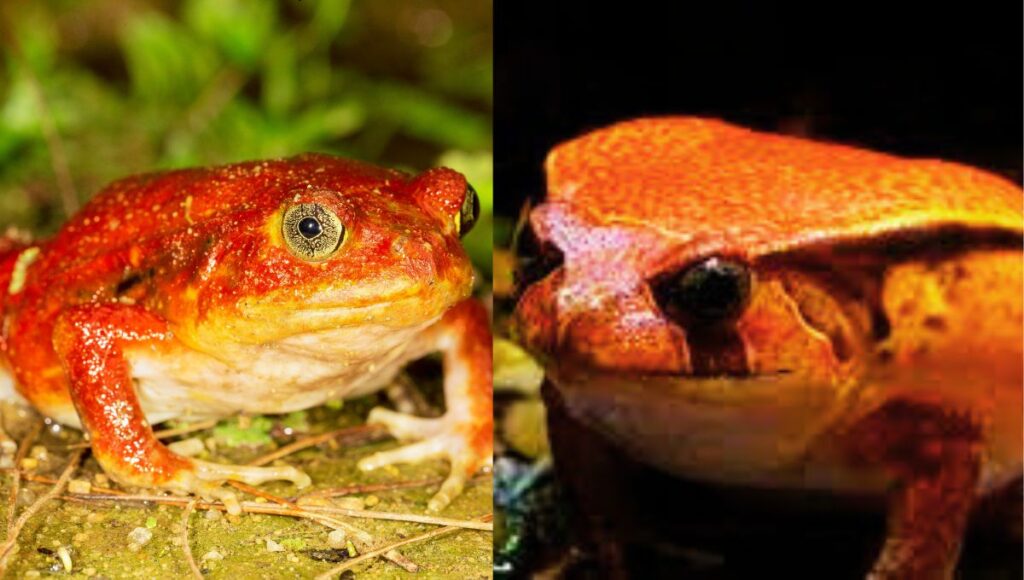
Table of Contents
Madagascar Tomato Frog- In a Glimpse:
| Common Name: | Madagascar Tiomato Frog |
| Scientific Name: | Dyscophus antongilii |
| Group Name: | Army, Colony |
| Adult Length: | 7-11 cm |
| Adult Weight: | 50-230 g |
| Colour: | Red or Orange |
| Distribution: | Madagascar |
| Habitat: | Moist sub-tropical forest, ponds etc |
| Diets: | Carnivorous, insects, mosquitoes etc |
| Characteristic: | Nocturnal |
| Predators: | Dogs, cats and birds |
| Breeding Season: | February- March |
| Sexual Maturity: | 2-3 years |
| IUCN Status: | Least Concern |
| CITES: | Appendix- II |
6 Interesting Facts about Tomato Frog:
Scientific Classification:
| Domain: | Eukaryota |
| Kingdom: | Animalia |
| Phylum: | Chordata |
| Class: | Amphibia |
| Order: | Anura |
| Family: | Microhylidae |
| Genus: | Dyscophus |
| Species: | Dyscophus antongilii |
Relatives:
| Common Name | Scientific Name | Madagascar | IUCN status |
| Sambava tomato frog | Dyscophus guineti | Madagascarr | Least Concern |
| Antsouhy tomato frog | Dyscophus insularis | Madagascar | Least Concern |
Physical Description:
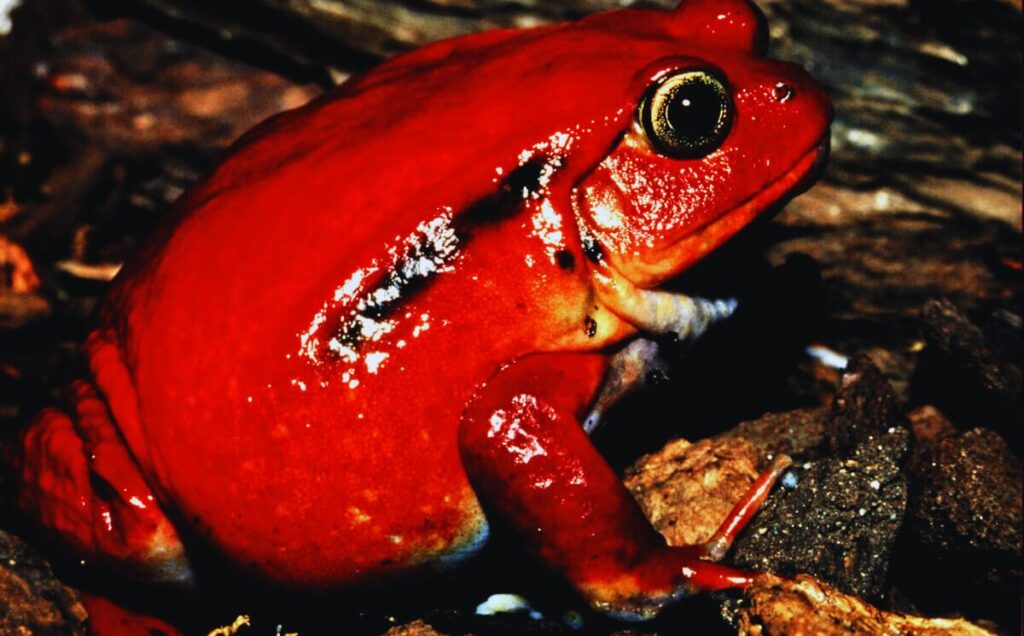
The medium-sized frogs show sexual dimorphism. The females are usually much larger than the males. The females can reach up to 11 cm in length and 230 grams in weight, whereas a male is 7 cm and weighs only around 50 grams.
The frog is famous for its vibrant red colour, which sends warnings to the predators about the toxicity of the frogs. Females have a bright red or orange tone on the back and a pale undersurface. Some individuals have black spots on their throats. Tomato frogs secrete a white jelly-like toxic substance from their skins to deter predators and humans.
Lifespan:
The average lifespan of tomato frogs is 6-8 years. The females can live up to 11 years whereas males can live up to 7 years.
Distribution and Habitat:
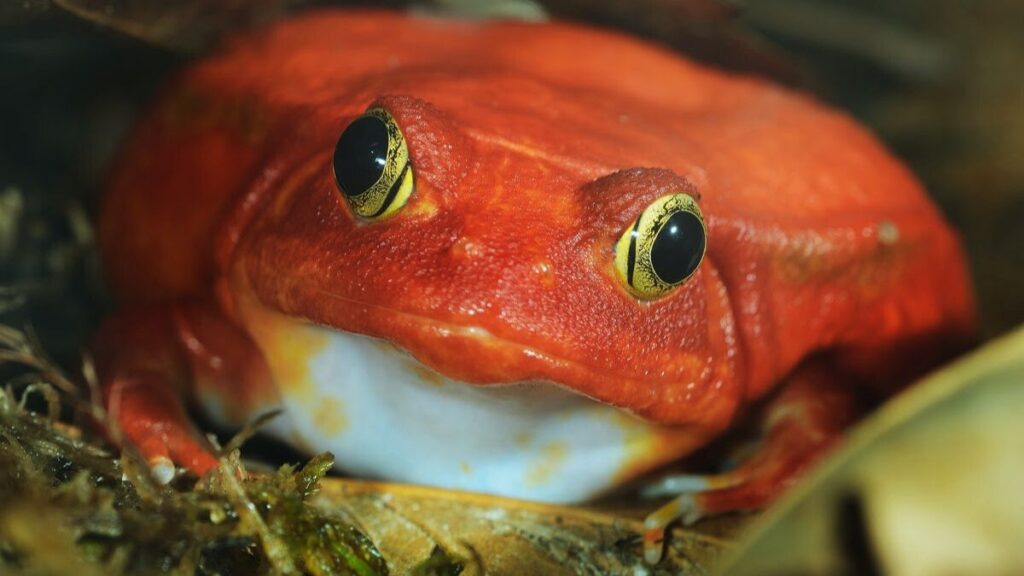
The frogs are endemic to Madagascar, especially northeast of Antongil Bay and south of Andevoranto. It is not possible to know its exact distribution as the species looks similar to the Sambava tomato frog.
Tomato frogs prefer shallow pools, swamps and areas of slow-moving water to breed. The frogs are usually found at a height of 200 m from sea level. Its natural habitat includes subtropical or tropical moist lowland forests, rivers, swamps, freshwater marshes, urban areas, ponds, canals etc.
Behaviour:
Tomato frogs can live beyond their specified range and adapt quite well in urban areas. The frogs are usually found in drains, farmland and ponds where they can easily access the slow-moving water. The frog exhibits the skills of burrowing on soft surfaces and in the wild.
Communication:
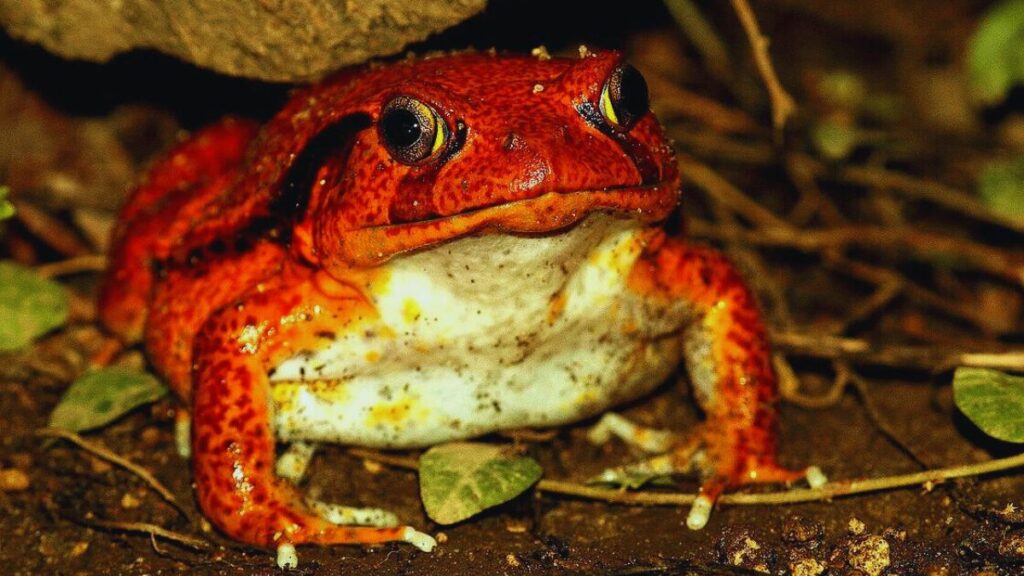
Like other Anurans cousins, the male frogs usually use their vocalization to call out their female partners. They also use their touch during amplexus to communicate while mating. They also use a high-pitched sound when threatened.
Diets:
Tomato frogs are nocturnal and can wait a whole night for prey. They consume worms, snells, small insects, arthropods and invertebrates. The frogs are strictly carnivorous.
Reproduction:
The frog species generally breed in February- March. The sound of males calling out the females in the thunderstorm can be heard from the poolside. After copulation, the female lays up to 1500 eggs on the surface of slow-moving water.
Within 36 hours, tadpoles are hatched from these black and white eggs. The tadpoles are only 6 mm long and feed by filter feeding. In the next 45 days, the tadpoles undergo metamorphosis and turn into yellow juveniles. The sexual maturity of the frogs is between 2 and 3 years.
Importance:
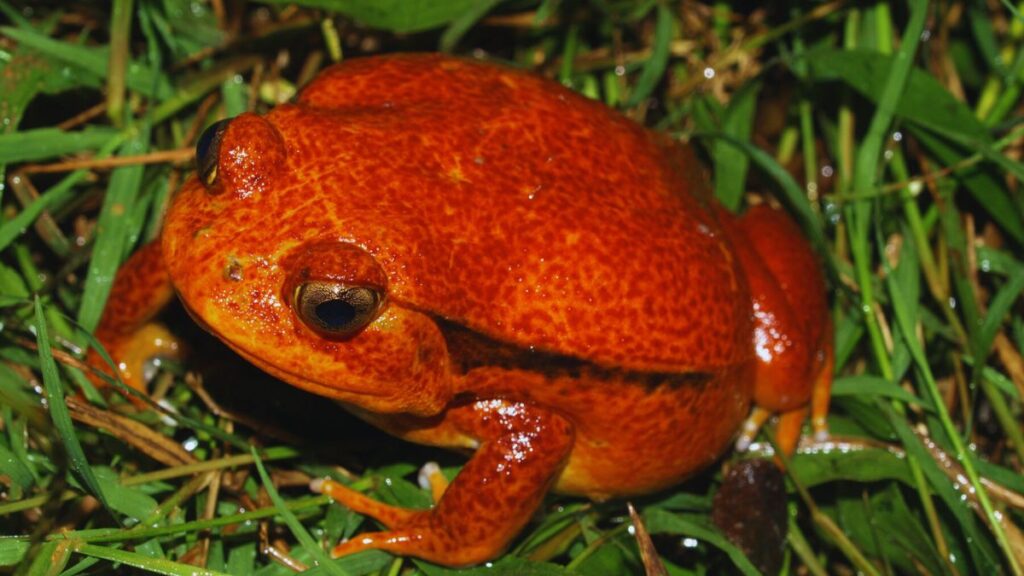
Due to its vibrant red colour, the demand for frogs as a pet in the Western world is insane. The farming of the frogs and captive breeding can generate more exports and create new jobs.
Threats:
The Madagascar Tomato frogs are facing many anthropogenic threats in the wild:
- Habitat degradation
- Pollution
- Hunting and poaching
- Affected by Invasive Species
Predators:
Common dogs, cats and large birds are the main predators of the tomato frogs.
Common Disease:
The most common health disease that affects Madagascar Tomato frogs is chytridiomycosis, which is a life-threatening skin disease caused by chytrid fungus. This disease is a serious threat to the Tomato frogs as well as other frog species around the world such as the Mountain Chicken frog.
Conservation Status:
Tomato frogs are listed as “Least Concern” in the IUCN Red List of Threatened Species and also “Appendix II” in CITES.
Are Madagascar Tomato Frogs good pets?
The bright red-orange color of the tomato frogs often attracts the pet lovers to keep them as pets but are they good pets which is safe for the family? Madagascar Tomato Frogs can be excellent pets, especially for beginners because they are easy to care for and don’t need much space to thrive. You only need a 10-gallon terrarium tank with a shallow water dish, some decoration, and a hiding place along with food to maintain these frogs. The tomato frogs are nocturnal and most of the time they live under a burrow. Hence you don’t need to worry about maintaining them.
There are also some cons of having Madagascar Tomato Frogs as pets which you must be aware of before purchasing them. The nocturnal frogs produce very noisy high-pitched sounds that can be heard all night and this sound can affect your sleep. The frogs don’t like to be touched by humans as it causes stress to them. They also secrete a white jelly-like toxic substance that causes eyes and face.
Additionally, Madagascar Tomato frogs are solitary by nature and often show cannibalistic nature. Thus, these frogs shouldn’t be kept in pairs in a container. If you keep two Tomato frogs in the same enclosure, ensure that they have enough space between them. Also, avoid keeping the frogs with other species of amphibians in the same tank due to their invasive nature.
How do you buy a Madagascar Tomato Frog?
Due to their habitat loss, Madagascar Tomato frogs are endangered in the wild and often become the victim of illegal trade and poaching. Hence, if you plan to buy a Tomato frog, purchase it from a reputable breeder or pet store that sells captive-bred specimens. Captive-bred frogs are much healthier and less likely to carry parasites or diseases compared to wild frogs.
However, you can check online platforms to buy the frogs but check the reviews, and policies, and also read if there are any laws in your country about the specific frog. Don’t forget to ask for proof of origin, health certificate, and other details before buying Tomato frogs.
The price of a Madagascar Tomato frog depends on their age, sex, size, colour, and location. The frogs will cost around $15-$30 based on your location. You also need a tank, substrate, water dish, thermometer, plants, and food to maintain the frog.
Requirements and Care:
Tomato frogs are endemic to Madagascar and they thrive in rainforests and swamp forests in the wild and slowly move towards stagnant but fresh water-bodies like ponds, lakes, or pools. You need to create a similar environment at your home to maintain the frogs.

Enclosure:
Tomato frogs require at least a 10-gallon terrarium tank and a shallow water dish. However, the bigger the tank, the better for the frogs. The frogs don’t need a lot of water but you must control the temperature and humidity of the enclosure. You’ll also need cork bark flats, branches, and hollow logs inside the tank, so the frogs can interact, play, and hide behind them.
Substrate:
Madagascar Tomato Frogs are usually territorial and they love to burrow and spend their time under that burrow. Hence you need a loose substrate such as plantation soil, eco earth, Topsoil, or coco fibre as these substrates can hold moisture. Ensure that these substrates are completely pesticide and fertilizers-free and safe for amphibians. The substrates should be at least two inches deep to give the frog enough room to burrow.
Plants:
You also need to decorate the enclosure with live or artificial plants otherwise, the environment will become boring to Madagascar Tomato frogs. As the frogs love to burrow, sometimes the roots of live plants get exposed. Thus, most of the owners prefer artificial plants inside the enclosure rather than live plants.
Temperature and Humidity:
Tomato frogs require warm as well as humid conditions to thrive. 65-85 degrees Fahrenheit temperature is the most suitable temperature for Madagascar Tomato frogs. You can use a thermometer to maintain the temperature of the enclosure. However, if the enclosure is cold, use a heat mat or heat lamp to warm it up and avoid overheating the tank.
Tomato frogs also need 70-80% humidity to survive. You can use a fogger or sprinkle water several times daily to maintain the humidity. Use a hygrometer to monitor the humidity level of the enclosure.
Light:
Madagascar Tomato frogs require a 12-hour light circle to regulate their daily activities. However, the frogs don’t need any special lighting, a normal spectrum bulb or a low wattage 2.0 or 5.0 UVB/UVA light bulb will be more than enough to keep the plants alive and provide the frogs with essential vitamin D.
Food and Water:
The frogs are primarily predators and strictly carnivorous. They feed on insects like beetles, flies, mosquitos, larvae, worms, mealworms, waxworms, superworms, pinkie mice, etc. Madagascar Tomato frogs hunt at night as they are nocturnal. You can feed them every other day to avoid obesity. The amount of food required depends on their age, sex, appetite level, and health condition. However, dust their food with calcium and vitamin supplements to provide them with proper nutrition.
Tomato frogs require soft-to-medium hard water with a neutral pH level and free from toxins. Remember, the water can be absorbed through their skin so ensure the water is not toxic. It is advised to provide them with clean, and dechlorinated water which is changed regularly. Despite being amphibians, Madagascar Tomato frogs can’t swim very well. Hence, the frogs prefer shallow and stagnant water.
Cleaning:
It is advised to clean their water dish, waste food, and dead insects from the enclosure regularly to prevent bacterial growth. Once a month you must deep clean the enclosure with dechlorinated water with a mild disinfectant and change the substrate every 10-12 weeks or earlier if it smells bad.
Handling:
Like most of the African frogs, Madagascar Tomato frogs don’t like handling and touching by humans. You can touch it very little, such as to transport the frog to another container while cleaning the tank but not more than that. If you touch tomato frogs unnecessarily, it’ll cause stress to them and the frogs secrete a toxic white jelly-like substance from their back. Hence, it is advised to wear gloves while touching them and wash hands with soap afterwards.
Frequently Asked Questions (FAQs):
Do tomato frogs have teeth?
Unlike other frog species, Madagascar Tomato Frogs have teeth. Their sharp teeth help them grind food.
Are tomato frogs vocal?
Yes. During the mating season and when threatened the male frogs execute a very high-pitched sound. Among them, the male Sambava tomato frogs are the most vocal and you can hear them at night near any moist place attracting the female partners.
Are tomato frogs good pets?
It depends on the owner’s experience. It is comparatively easier to fulfil their needs and take care of them. The food is usually available easily and the frogs can adjust in any environment. But remember, the frogs are toxic and they release white jelly-like substances from their skin, that can cause skin problems and rashes to humans.
Can 2 tomato frogs live together?
The tomato frogs are solitary by nature and known for cannibalistic behaviours. You can keep 2 frogs but you need to give them enough and separate space for each frog.
How big an enclosure do you need for a tomato frog?
The frog species prefer shallow water. A 10-gallon terrarium with a shallow water dish is needed for the frogs. The frog species don’t need a lot of water but they need a moist environment.
Are tomato frogs safe or poisonous?
The frogs are poisonous. They secrete a jelly-like white substance that discourages predators. The substance is also harmful to humans as it causes skin rashes and itching. If you want to keep the frog as a pet, you should be careful of this fact.
Also Read; Cape Rain Frogs: 8 Fascinating Facts About African Amphibian